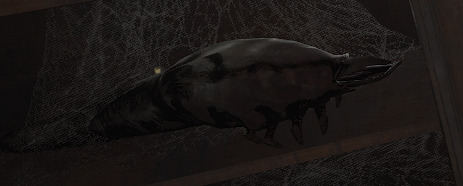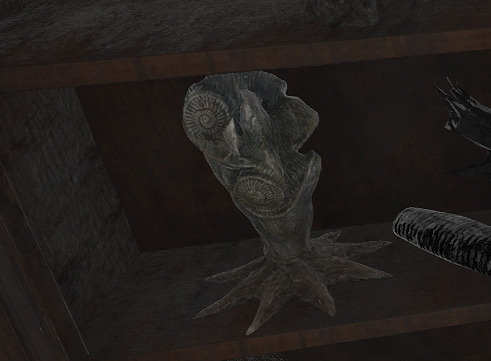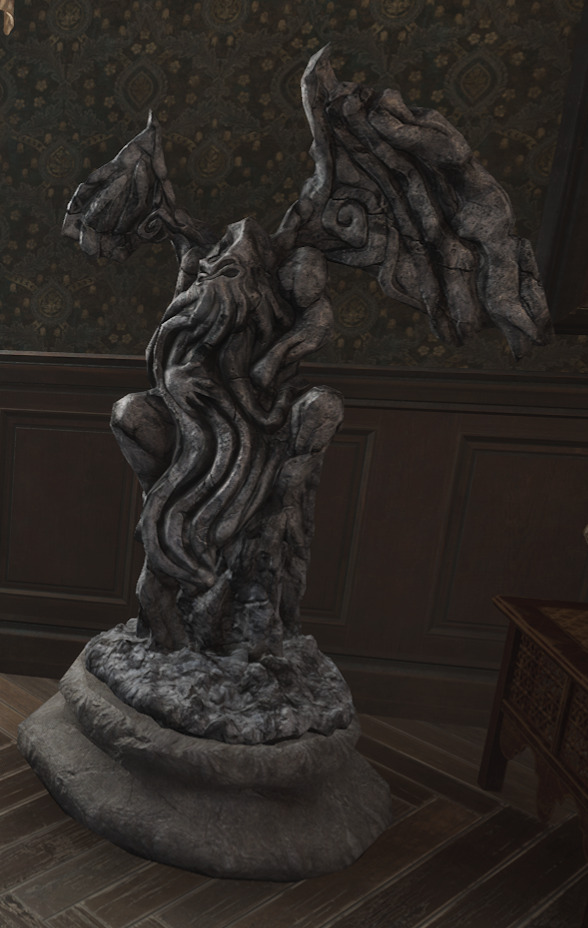#by repeatedly getting put in the torment dimension. but he would still have those struggles even if shta never happened ykwim
Explore tagged Tumblr posts
Text
its a little funny that violets curio room is full of reused models from sinking city used as hoaxes/fakes (just a few as an example)




and then they get used again in the awakened where its. Ummmm. well. kind of adds to the "was this real or not" thing in shta in a fun way
#im in the 'it was all real' camp for the record but violets mental illness is unrelated b/c that would be lame as fuck#to be like ohh it was cthulhu the whole time. NO. they just both happen independently.#also sherlocks mental illness wasnt ~caused~ by the Great Old One Madness or whatever. but his struggles w reality were not helped#by repeatedly getting put in the torment dimension. but he would still have those struggles even if shta never happened ykwim#frogwares holmes#i havent finished tsc so if some of the other models in there are also from it i wouldnt know. i suspect that the big fish carving slab is#but i havent seen it and dont want to be wrong. hi centipede#i hope cthulhu gets vogel and like eats all of his skin or something
17 notes
·
View notes
Text
SyFywire
THE COMPLICATED HISTORY OF RAVEN
Sara Century
@saracentury
Jun 27, 2019
Trigger warning: Raven’s backstory includes depictions of torture that will be discussed in this article.
Appearing as a central character not only in Teen Titans Go! but also in the live action TV series for DC Universe, Raven is a character with a lot of recent attention but a great deal of unknown history as well. Her origin is far from a simple and takes a lot more explaining than your standard DC comics backstory.
While it’s great that Raven is a complicated character with a lot of background, there’s a significant amount of uncharted territory in her story. That, combined with a lot of weird creative choices, lack of consistency in writing, and more retcons than you can shake a stick at, and you have one of DC’s most versatile concepts, as well as one of its most convoluted histories.
New Teen Titans #1, written by Marv Wolfman, art by George Perez, Romeo Tanghal, and Adrienne Roy, lettering by Ben Oda
The first appearance of Raven was in DC Comics Presents #26, alongside other new characters like Cyborg and Starfire, with Beast Boy (then going by Changeling), Robin leading the team, and Kid Flash along for the ride. She was attempting to build an army to defend Earth against her demon father Trigon, although she didn’t mention that to the team she assembled. Initially, she went to the Justice League for help, but Zatanna sensed her demonic heritage and advised the JLA against trusting her. Raven instead brought the Titans together ostensibly to battle against an amorphous space creature. They become a team without questioning her too much, which in the long run turns out to be a mistake. Specifically, Kid Flash is obsessed with her, although later we learn that she was likely manipulating his emotions to ensure he would protect her from her father. This is not the only time Raven would struggle with the concept of consent. While it makes sense considering how and where she was raised, her treatment of the Titans is not always great.
One of the most interesting things about Raven is that she comes from a pacifist society and has no interest in fights. She very much avoids them whenever possible, although in some issues her aggression shows through. In New Teen Titans #30, the villainous Brotherhood corners her in a church, and she immediately assures them she’s ready to fight to the death and prepares to attack. They, particularly the member Phobia who can control fears by inducing nightmarish hallucinations, respond with some surprise, used to a much more passive character. Phobia insists that they fight outside instead, and they end up capturing Raven. In #31, she is tormented by Phobia and sent into a deep dream in which she’s being pulled apart by hands. By the end of the story, she very nearly kills herself to avoid losing control over herself but is barely saved by the Titans.
New Teen Titans #31, written by Marv Wolfman, art by George Perez, Romeo Tanghal, and Adrienne Roy, lettering by Bob Oda
Raven continually drops hints about her origin but takes a long time to fully reveal her story. Her mother, Arella, had been part of a small cult that worshipped a demon named Trigon, although Arella was in way over her head and didn’t understand that they planned to sacrifice her to him. The demon took her by force, and a traumatized Arella eventually gave birth to Raven. Raven was then raised by a person named Azar in the dimension Azarath. Azar taught her to be in control of her powers and emotions at all times, lest her empathy be weaponized against her and indeed everyone around her. In her late teens, Raven discovered that Trigon planned to destroy Earth and that he intended to use her to do it. By the Titans realize this, Raven had become fully possessed by her father.
Raven was presumed dead or at least missing for a time, then reemerged enthralled to Brother Blood. At this time, Raven took to wearing all white rather than the bluish-grey costume she had made her first appearance in, and she made some efforts to regain her innocence while also trying to assimilate to society for the first time in her life. She became friends with Jericho, another troubled soul who would later deal with his own father issues and die while possessed. They kind of had a lot in common, and while we don't see them interact much at this point, their friendship was always a deeply felt one.
For a long time, Raven went evil, died, and came back from the dead more often than even Jean Grey. Through several retcons and reboots, we repeated her possession by her father and her enthrallment to Brother Blood, but some positive changes in her character began to slowly emerge. She began dating Beast Boy, who was never a great match for her emotionally but did what he could to care for and protect her. Most importantly, his concern for her came from a genuine place and wasn’t something she had to manipulate him into. She took on the civilian identity Rachel Roth and attempted to attend high school. She allowed herself to look away from her troubled interior life and actually interact with people. In short, although it was a long time coming, Raven has slowly begun to humanize and socialize herself, and over several years it has led to an actual positive change in her life and in her outlook.
Everything about Raven’s responses makes her read as someone with a long history of trauma. Her highly specific fear of her father is fascinating, and relatable for a lot of people that grew up with bad dads. In her early days, Raven fully acknowledged that her best case scenario was to die defending the world rather than become the monster that helped bring about its destruction. When she died (repeatedly) in a battle against her father, she was fulfilling the prophecy everyone around her had been telling her since her early childhood. As a character without a future, Raven’s ability to make connections or have stability in her life suffered and helped to cause her ultimate collapse. Again, for people that have been in some way forced to constantly choose between their fight or flight response and their desire to make real connections in life, Raven is a beacon.
Titans #5, written by Judd Winick, art by Julian Lopez, Rodney Ramos, and Edgar Delgado, lettering by Rob Clark JR
Raven was born from an act of violence. Like so many children of abuse, she was raised with a great deal of emotional baggage from day one. Her mother feared her and feared for her, so she gave her away to be raised by Azar, a spiritual leader that offered little emotional warmth. She never truly had a mother figure, save for the person that advised and trained her not to show affection or emotion lest the world collapse around her. Raven was born into trauma, and her bizarre antisocial behavior and thorny vulnerability indicated that from the start. The constant state of fear that she exists in, terrified of becoming her father, is almost impossible to even fully imagine... unless you've gone through something similar yourself.
On the other hand, Raven remains a strange type of role model in the valiant way she denies what others perceive to be her inescapable fate. Despite existing in a constant state of anxiety and being broken down by various villains, again and again, she always seems to put herself back together, and her past self only exists as a piece of a puzzle that she’s still trying to form. Children that suffer trauma at early ages often have great difficulty forming friendships and assimilating to society as they come of age. Raven is an interesting character because we get to watch her as she makes those efforts, and as such, she can serve as a beacon to people that are suffering and likewise flailing towards some sense of wholeness they have yet to possess.
Teen Titans Go! crossing over with old school Teen Titans series for mystery project
Oct 25, 2018
Tara Strong on how Teen Titans Go! is a 'spiritual continuation' of the original series
Jul 26, 2018
More recently, in Teen Titans Go!, we’ve seen a Raven who is dark and weird but genuine, optimistic, and funny, which indicates a great deal of character growth from the nervous, unbearably shy character we’ve been seeing in comics for decades now. Wherever Raven goes as a character, it’s important to remember her willpower and her slowly developed and dry sense of humor as being as tantamount to her character as her trauma could ever be. It is most important for readers that have experienced massive amounts of suffering at young ages to be able to portray her trauma without obsessively retreading her deepest pain issue after issue. Above all, Raven has grown from who she once was, and it is that evolving maturity that makes her such an important character to the Titans.
Teen Titans Go! via Time/Warner
Fangrrls
TV
Comics
Raven
Titans
New Teen Titans
Teen Titans Go!
DC Comics
1 note
·
View note